MacBook Pro with Touch Bar (13-inch, Mid-2017) review
A faster, but still divisive, MacBook Pro
OUR VERDICT
The new MacBook Pro is a marked improvement, but clinging onto previously divisive design decisions only continue to hurt it in straight comparisons. While this update certainly doesn’t disappoint, apply due diligence before clicking the ‘buy’ button.
FOR
- Stronger processor
- Faster RAM
- Same excellent design
AGAINST
- Subpar battery life
- Keyboard learning curve
- Awfully pricey for the parts
Among all the price drops and discounts we’ve seen in recent months, interestingly enough, there hasn’t been much in the way of substantial changes to the MacBook Pro or its accompanying operating system, macOS 10.13 High Sierra. What we have seen are security updates and a horde of new emoji shared with iOS.
That being the case, the latest 13-inch MacBook Pro with Touch Bar is anything but revolutionary. Instead, it offers a handful of subtle niceties that should have been present in last year’s model but, for some reason or another, didn’t make the cut. In other words, it may not be the best MacBook Pro for everyone, but it is the best 13-inch MacBook Pro with Touch Bar you can buy.
The issues we took with last year’s refresh are mostly still present, with the exception of the high price, a factor that’s been somewhat mitigated on the entry-level side of the spectrum. The only ports it has are still USB Type-C (Thunderbolt 3) and a headphone jack, and although iPhone users are likely envious, Mac power users expect more from their computers. After all, until 2016, every MacBook Pro had video-out, absent the need for adapters.
Nevertheless, we have to give Apple the benefit of the doubt to an extent, as there were only so many improvements that could be made in the seven-month span between releases. Knowing full well that your purchase of a 2017 MacBook Pro will net you a slightly more powerful version of last year’s model, read on to find out our consensus of how this fares for the Cupertino tech giant.

SPEC SHEET
Here is the 13-inch MacBook Pro configuration sent to TechRadar for review:
CPU: 3.1GHz Intel Core i5-7267U (dual-core, 4MB cache, up to 3.5GHz)
Graphics: Intel Iris Plus Graphics 650
RAM: 8GB (2,133MHz LPDDR3)
Screen: 13.3-inch, 2,560 x 1,600 Retina LED display (IPS, 500 nits brightness, wide color P3 gamut)
Storage: 256GB SSD (PCIe 3.0)
Ports: 4 x Thunderbolt 3 (USB-C), headphone/mic jack
Connectivity: 802.11ac Wi-Fi, Bluetooth 4.2
Camera: 720p FaceTime HD webcam
Weight: 3.02 pounds (1.37kg)
Size: 11.97 x 8.36 x 0.59 inches (30.41 x 21.24 x 1.49cm; W x D x H)
Graphics: Intel Iris Plus Graphics 650
RAM: 8GB (2,133MHz LPDDR3)
Screen: 13.3-inch, 2,560 x 1,600 Retina LED display (IPS, 500 nits brightness, wide color P3 gamut)
Storage: 256GB SSD (PCIe 3.0)
Ports: 4 x Thunderbolt 3 (USB-C), headphone/mic jack
Connectivity: 802.11ac Wi-Fi, Bluetooth 4.2
Camera: 720p FaceTime HD webcam
Weight: 3.02 pounds (1.37kg)
Size: 11.97 x 8.36 x 0.59 inches (30.41 x 21.24 x 1.49cm; W x D x H)
Price and availability
Although you can snatch one for yourself at $1,299 (£1,249, AU$1,899), that MacBook Pro configuration lacks a key element: the OLED Touch Bar that replaces the function keys on higher tier models. If the Touch Bar, along with Touch ID verification, is on your must-have features list, you can expect to shell out no less than $1,799 (£1,749, AU$2,699).
Now, while you could simply fetch more storage than the base configuration for $200/£200/$300, the unit we reviewed is a supercharged beast. That’s due in part to the fact that it sports four Thunderbolt 3 ports, double that of the non-Touch Bar models, all of which can be used to charge the device. Moreover, the processor speed has been bumped from 2.3GHz to 3.1Ghz as well.
For $100 less in the United States, however, you can get a Dell XPS 13 with double the RAM and storage of the $1,799 MacBook Pro we’ve reviewed here and with a more capable Intel Core i7 CPU at that – not to mention a sharper 3,100 x 1,800 touchscreen as well as both Thunderbolt 3 and an SD card reader.
Similarly, the Surface Laptop, which can be configured with a stronger Core i7 CPU and equally capacious storage and RAM for a full 200 clams less, albeit with a slightly lower-resolution 2,256 x 1,504 touchscreen and only two legacy ports.
These comparisons make it abundantly clear that you’re buying a MacBook Pro these days neither for the power nor the price, but the platform and pedigree. Regardless, these comparisons only grow more difficult to draw for Apple’s leading laptop these days.
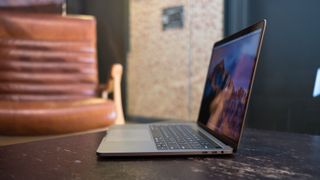
Design
Luckily, Apple’s pedigree does wonders for maintaining the MacBook Pro’s shining reputation as an absolutely beautiful and sensible computing device. That said, not much – if anything – has changed about the MacBook Pro design year over year, and that’s A-OK.
Still available in Apple’s standard space gray or silver colors (no rose gold yet), the MacBook Pro’s unibody aluminum shell is as gorgeous as ever, giving off a subdued shine through the anodization.
In terms of form factor, Apple maintains its achievement of cramming a 13-inch screen into an 11-inch frame a la the Dell XPS 13, but this laptop’s bezels are still a bit larger. Speaking of screens, Apple’s Retina display is as sharp and color-rich as ever, even more so with its new, professional-grade P3 color gamut.
However, it’s far from the sharpest out there, even among its strongest rivals, making its “Retina” claims tougher than ever to swallow. For instance, the XPS 13 can be configured with a 3,200 x 1,800 QHD touchscreen, easily outclassing the MacBook Pro in terms of pure sharpness.
This is a hugely important point for creative professionals working with media files that are high-resolution or require such a resolution to resolve minute details upon zooming in on a media file.
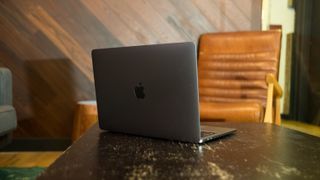
At any rate, the MacBook Pro is uniformly thinner than the XPS 13 by a hair, which starts from 0.6 inches and tapers off at 0.33 inches. The Surface Laptop, meanwhile, is marginally thinner than both at just 0.57 inches.
This is the thinnest and lightest MacBook Pro yet, and for that it feels right at home in our backpack – that is, assuming we don’t forget it’s even there. (Trust us, it has happened during this review, and it was horrifying.)
That Apple managed to craft a laptop this thin and still maintain top-firing stereo speakers, with deep and rich sound no less, should be commended when most other laptop makers just go for down-firing speakers. Instead, where speakers would normally go on an Ultrabook, Apple has placed intake fans that draw cool air in and spit it out the back just beneath the hinge.
Sure, the laptop heats up still right around that area, but said heat is far away from the more sensitive parts of your lap and far less dramatic than with previous models.
As for how Apple managed to make the MacBook Pro this thin, a key culprit is the laptop’s new keyboard with Apple’s 2nd generation butterfly mechanism, introduced in last year’s model. The improved actuation device doesn’t make the keys sit any more flush with the keyboard deck than they already were last year, but rather vastly improves the tactile feel of typing.
Feedback is much more forceful this time around, though the key travel doesn’t feel as if it’s changed much, which is the point ultimately. The keys are large enough so as not to miss given the lack of travel, though we’re not fans of the Escape key being relegated to the Touch Bar – something we’ve accidentally pressed more than once – and the tight positioning of the up and down arrow keys.
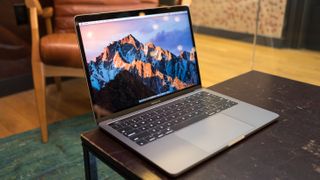
Also, we find typing on this keyboard to be louder than on Apple’s older MacBook keyboards, but perhaps that’s due to adjusting to the learning curve.
A mixed takeaway from the keyboard aside, the new-and-enlarged Force Touch trackpad was a welcome improvement last year and we’re just as happy to have it this time around. Its large size and strong palm rejection help immensely with multi-touch gestures and, more importantly, navigating the operating system the easier way, i.e. with your index finger moving the cursor and your thumb clicking the buttons.
Speaking of which, Force Touch returns to the trackpad, naturally, and it’s frankly remarkable. The vibration motors beneath the glass tracking surface vibrate so as to recreate the feeling of a mouse click, and, if Apple didn’t make such a stink about, it we’d be none the wiser. This is Apple’s “it just works” philosophy realized once again.
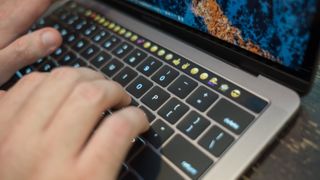
Touch Bar and Touch ID
While many have been quick to dismiss the Touch Bar since its introduction in last year’s MacBook Pro model, we’ve come down on it with a bit more understanding. You see, while we admittedly didn’t naturally come to use the Touch Bar much at all during the course of this review, its presence and potential are nevertheless noted.
While still relegated to supporting core macOS functions and a few, major third party apps (like Adobe Suite), the Touch Bar is incredibly fast at adapting to the task at hand. The strongest example of this is simply the Touch Bar’s built-in spell checker, which is constantly suggesting words no matter how fast of a typist you are.
It’s almost like having the iPhone’s autocorrect function on your MacBook.
We’ve seen tech like this attempted before, but in no way this robust and quick. The OLED touch display is incredibly responsive, and its matte coating does well to shrug off glare from strong light sources – just don’t expect much in direct sunlight. All said, we’re impressed by the technological achievement that the Touch Bar is, but still believe it requires wider third party support to become a must-have feature.
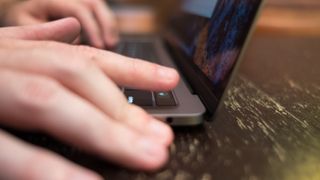
Though, having Siri as a button for easy, constant access is a major plus, given the wide control it has over macOS in comparison to other digital assistants.
The second piece of the Touch Bar offering is, of course, Touch ID. While this is the second go around for the technology, we’re nevertheless happy that biometric login is finally available on an Apple laptop. The tool works just like it does on iPhone, and it’s just as quick.
That said, we’ve found Windows 10’s iris-scanning Windows Hello tech to be faster and require nearly zero effort. (To achieve this level of immediacy with a Mac, you’d need an Apple Watch with the Auto Unlock feature activated.) Regardless, being able to securely log into the laptop, and pay for things through Safari via Apple Pay, are both features we’d be clamoring for if they weren’t there.








0 comments: